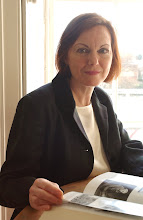
 Jane Hyslop e.mailed me from Canada with this story of her x3 grandmother, Sarah Green, who was born around 1816.
Jane Hyslop e.mailed me from Canada with this story of her x3 grandmother, Sarah Green, who was born around 1816.Sarah Green gave several places as her place of birth on the Census entries from 1851-81. Usually she gave Great Clacton, Essex, and once she stated Colchester, Essex, between the years 1812-13. There is no baptism entry on the IGI (International Genealogical Index, Mormon Library) to verify the exact place. Her marriage certificate indicates her father was William Green, a labourer.
Sarah appears in Russell Square, Bloomsbury (top picture courtesy GothPhil, Flickr), on the 1841 Census as a F.S. (Female Servant?), age 25, N (not born in the County). She is one of 4 female and 1 male servants in the household of John Foster, whose household lists 6 family members beside himself, 4 female and 1 male servant. As there is no listing of specific duties we cannot know if Sarah was a kitchen maid, governess or cook. Mr Foster’s occupation is blank except for the abbreviated word Ind., presumably meaning 'Independent', obtaining his income from private means. The house next door to the Fosters was inhabited by Henry S Roots, a physician. So although we don’t know the Foster’s house by street number, it was next door to Dr Roots (more of him in the next blog).
On 16 April 1843 Sarah married Christopher Best at St George’s, Bloomsbury. She gave her address as Upper Bedford Place (possible number 6 but the entry is illegible. This is now Bedford Way), Bloomsbury, and her occupation as Servant. The witnesses were Sarah and George Johnson (relationship to Sarah Green unknown). Christopher Best was a Mason by trade living on Little Guildford Street (now incorporated into Herbrand Street), the son of John Best, Cordwainer. Christopher was born in Kingston-upon-Hull, Yorkshire, and had gone to London in search of work after 1841. He was not a resident of Hull, his family were natives of Heighington, County Durham, a village near Darlington.
Sarah and Christopher lived at 7 Cowley Street in Smith Square, Westminister when their first child, Sarah Mahala, was born on 14 Jul 1844. They were still there in 1845 at the birth of their son Christopher on 2 Oct 1845. They had returned to the north, Darlington, County Durham, by the birth of their third child, Ann, in May 1848. Sarah and Christopher had 6 children (3 died in infancy). It is unknown when Sarah died. She appears in the 1881 Census for Darlington as a Widow (Christopher had died in 1860). It is undetermined whether she left the area or remarried.
From her presence in Bloomsbury, it is assumed Sarah went to London in search of work and found employment in a house at Russell Square. Since little else is known about her family it is unclear if she was living near to family members who also worked in service. Her reason for choosing London is presumably more opportunity for employment than in the small rural villages of Essex. No photos survive of Sarah or Christopher Best.
The bottom photograph (courtesy Jamie Barras, Flickr) shows the Peabody buildings in Herbrand Street which were completed in 1885, long after Christopher Best had left the area. The street had become a slum and these superior apartments were built to rehouse working people. Peabody buildings, of which there are a number around London, were intended for 'respectable' working class tenants rather than the indigent poor or those out of work.
 Who owns our health? This is the question asked by Dr Vivienne Lo who planted our medicinal herb garden in Mecklenburgh Square. The garden includes an intriguing herb spiral landscaped from Welsh slate.
Who owns our health? This is the question asked by Dr Vivienne Lo who planted our medicinal herb garden in Mecklenburgh Square. The garden includes an intriguing herb spiral landscaped from Welsh slate. 



























